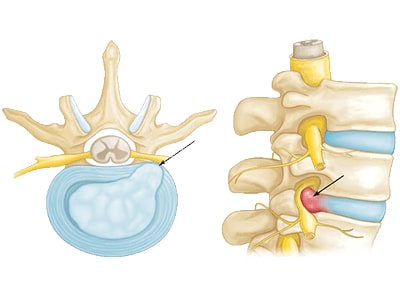What is a Slipped Disc?
A slipped disc, or herniated disc, is medically known as a prolapsed disc. And when the hard, outer disc portion weakens, a slipped disk occurs. Then the soft inner disc portion leaks through. As a result, compressing or irritating sensitive spinal nerves occurs.
Now, lets back it up a little and talk about the spinal column. The spinal column includes bones stacked up on top of each other. And it makes up of three parts. Such as the cervical spine, thoracic spine, and lumbar spine, and are cushioned by disks. Additionally, these discs protect the bones by absorbing the shocks from activities. These activities include walking, twisting, and lifting.
When breaking it down, each disc has two parts; a gel-like inner cushion, and a hard outer shell. After an injury occurs, it weakens the soft-like inner gel. As a result, this causes protrusion through the tough outer shell. Additionally, pain and discomfort are typically present. Sometimes, a slipped disk can even compress a spinal nerve. Eventually, causing numbness and weakness in the affected area.
Nonetheless, some slipped disks don’t cause any pain at all! And treatment is only required if ongoing pain occurs or if the discomfort begins to interfere and affect a patient’s quality of life.

Slipped Disc Symptoms
- Severe pain. Located on one side of the body.
- Radiating pain down into the legs or the calves or feet.
- Tingling or pins-and-needles sensations.
- Numbness or weakness. Occurring in the buttocks, legs, or feet.
- Unexplained pain that worsens at night.
Slipped Disc Causes
- Repeated improper movements. Due to sports, improper lifting or too much sitting.
- Unexpected or sudden trauma or accident.
- The natural aging process.
- Smoking.
- Obesity and lack of exercise.
One of the basics approaches of physical therapy when treating a slipped disk is targeted at stretching and constant exercises. This aids in rehabilitation and helps strengthen the back muscles.
Surgical Treatments
Nowadays, most surgical procedures to treat slipped discs are minimally invasive. That being the case, a hospital stay is not required. As a matter of fact, SOC is well known for its success rate in treating slipped disc. However, there are many surgical procedures for slipped disc, such as:
Anterior Cervical Discectomy Fusion Instrumented
First, the ruptured disc is removed. And, then, replaced by a bone graft. Lastly, for stability, an anterior cervical plate is implanted.
Posterior Cervical Laminotomy
In this procedure, the spinous process and lamina are first removed. This allows for decreased pressure on the spinal cord. Instrumentation sometimes is used to increase post-operative stability.
Lumbar Partial Discectomy
Removal of the slipped portion relieves pressure on the painful nerve.
For more information on slipped disks and possible treatment options, call our specialists now at 888-409-8006. Our offices are conveniently located in South Florida.
